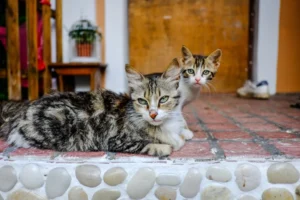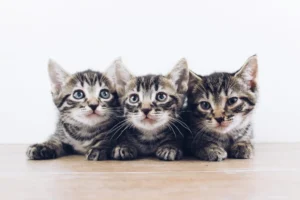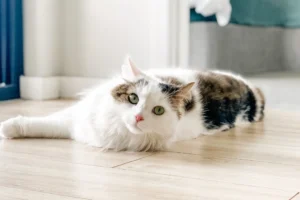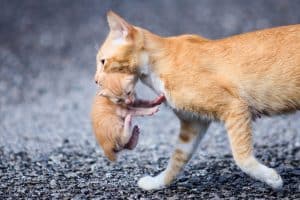Cats and milk have a long-standing relationship that many people find intriguing. But why are cats so attracted to milk? The answer lies in their instincts and the unique appeal of this dairy product.
Natural Instincts:
Cats’ affinity for milk can be traced back to their natural instincts. In the wild, mother cats produce milk to nourish their kittens, instilling a deep connection between cats and this nutritious liquid. This association is so ingrained in their instincts that even as adults, cats may still be drawn to the smell and taste of milk.
Moreover, milk is rich in fat and protein, which are essential nutrients for cats. Their instinctual drive to seek out these nutrients may explain why they are attracted to milk even if they may not fully process lactose, the sugar found in milk.
While not all cats are lactose intolerant, many adult cats lose the ability to digest lactose as they age. This may lead to digestive issues if they consume milk. However, the instinctual attraction remains strong, showcasing the powerful influence of natural instincts on cat behavior.
Evolutionary Factors:
The evolutionary roots of cats’ attraction to milk can be linked to their ancestors’ diet. Wild cats, such as lions and tigers, would occasionally consume milk by hunting and preying on lactating animals in their natural habitats. This behavior allowed them to access additional sources of nutrients during times of scarcity.
This evolutionary trait of seeking out milk as a supplementary food source may have offered survival advantages to their ancestors. Cats that could digest milk and benefit from its nutritional content may have had a better chance of thriving in different environments, leading to the perpetuation of this attraction in modern-day domestic cats.
Interestingly, the lactose content in milk can vary across different species. For example, cow’s milk has higher lactose levels compared to the milk from cats’ natural prey like rodents. This variation may influence cats’ tolerance to milk and their ability to digest it effectively.
Extra Tip: Providing specially formulated cat milk as an occasional treat can be a safer alternative for cats who are attracted to milk but struggle with lactose digestion. This can satisfy their instinctual cravings while minimizing the risk of digestive issues.
Nutritional Benefits:
Cats are attracted to milk due to its high protein content, which is essential for their muscle growth and overall health. Additionally, milk contains calcium, which is crucial for maintaining strong bones and teeth in felines. The fat content in milk provides cats with a good source of energy to fuel their active lifestyle. Furthermore, the lactose found in milk can be appealing to cats as it mimics the taste of their mother’s milk, creating a sense of comfort and familiarity.
Sensory Appeal:
The sensory elements of milk play a significant role in attracting cats to this beverage. The taste of milk is often described as creamy and rich, appealing to a cat’s refined palate. The smell of milk can also be enticing to cats, as it may remind them of the scent of their mother. Additionally, the texture of milk is smooth and liquid, making it easy for cats to lap up and enjoy. These sensory experiences combined make milk a desirable treat for cats.
Unique Insight or Angle: Interestingly, cats’ attraction to milk may also be linked to behavioral factors. In the wild, cats rely on milk from their mother for nourishment during their early stages of life. This instinctual connection to milk may explain why cats are drawn to it even as adults, as it triggers a sense of comfort and security.
Past Behavior:
Cats’ historical interaction with humans plays a significant role in their attraction to milk. Back in the day, dairy products were scarce, so when cats were around human settlements, they’d sneak sips of milk left out in the open. This behavior became ingrained in their DNA over time, leading to the common perception of cats and milk as a classic pairing. While this historical background sheds light on their affinity for milk, it’s essential to note that not all cats can digest lactose effectively, which can lead to stomach upset.
Alternatives to Milk:
When it comes to satisfying your cat’s craving for milk without risking any health issues, there are plenty of alternatives you can turn to. Consider offering lactose-free milk specially formulated for cats, which mimics the creamy texture without the lactose that causes digestive problems. Another option is to provide wet cat food mixed with a bit of water to create a similar consistency to milk. Additionally, plain water or bone broth can also be great alternatives that are safer and healthier for your feline friend. Remember, always consult with your vet before making any significant changes to your cat’s diet to ensure it aligns with their specific nutritional needs.
Alternative Options for Cat Owners: 1. Lactose-free milk designed for cats 2. Wet cat food mixed with water 3. Plain water or bone broth
By providing these safe and suitable alternatives, you can satisfy your cat’s desire for milk while keeping their health and well-being a top priority.
Myth Busting:
Contrary to popular belief, not all cats are lactose intolerant. While many adult cats may have difficulty digesting lactose, some cats may actually be able to tolerate small amounts of milk without any issues. It ultimately depends on the individual cat and their unique digestive system. It’s important to monitor your cat’s reaction when giving them milk and consult with your veterinarian if you have any concerns.
Healthy Treats:
If you’re looking for cat-friendly treats to satisfy their craving for milk without the risk of upsetting their stomach, consider offering alternatives such as plain yogurt or broth. These options can provide a similar creamy texture and enticing flavor without the potential digestive issues that milk may cause. Additionally, cooked chicken or fish can also be excellent options for a healthy and satisfying treat for your feline friend.
Other suggestions include:
– Catnip: A favorite among many cats, catnip can be a fun and stimulating treat.
– Freeze-dried meat: An excellent source of protein and a tasty snack for your cat.
– Green beans: Surprisingly, some cats enjoy the crunch and taste of green beans as a treat.
Remember to always provide treats in moderation and consult with your veterinarian if you have any concerns about your cat’s dietary needs.
Interesting Facts:
Cats are known for their love of milk, but did you know that not all cats are actually attracted to milk? In fact, many adult cats are lactose intolerant and may experience stomach upset if they consume milk. This is because cats lack the enzyme lactase, which is needed to properly digest lactose, the sugar found in milk. While some cats may enjoy the taste of milk, it’s best to stick to water or specially formulated cat milk to avoid any tummy troubles for your feline friend.
Interestingly, the association between cats and milk dates back centuries. In the past, cats were often found living in barns or on farms where they would lap up milk from cows. This led to the popular belief that cats have an inherent attraction to milk. While this may be true for some cats, it’s important to remember that not all cats can handle dairy products. It’s always best to consult with your veterinarian before offering milk to your cat to ensure their health and well-being.
Overall, while the idea of cats and milk may seem like a classic pairing, it’s essential to understand the dietary needs of your cat before offering them this treat. Remember, not all cats are the same, and what works for one may not work for another. So, when it comes to treating your feline friend, it’s best to err on the side of caution and stick to cat-friendly options.
Alex, a passionate animal lover, has experience in training and understanding animal behavior. As a proud pet parent to two dogs and three cats, he founded AnimalReport.net to share insights from animal experts and expand his knowledge of the animal kingdom.









